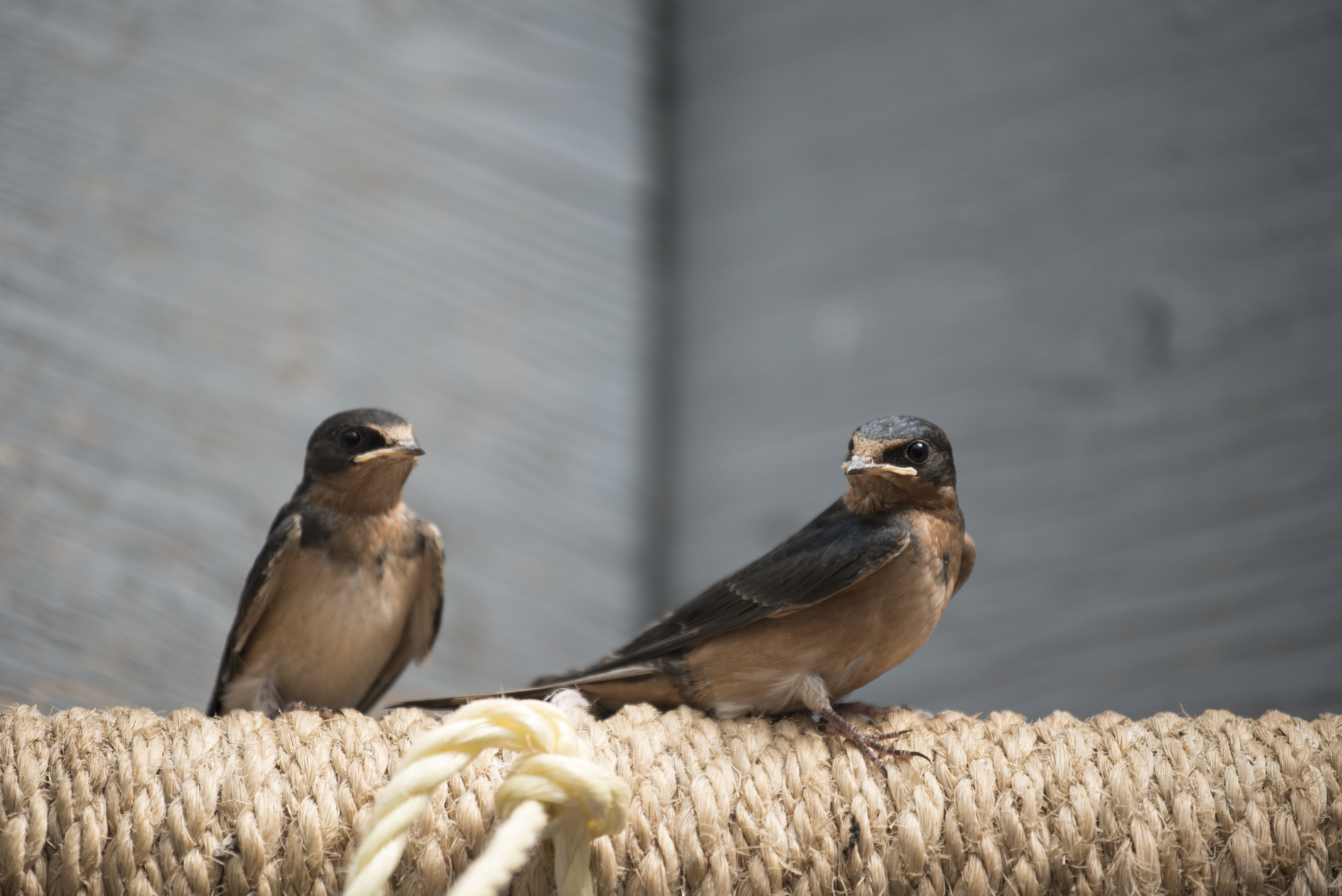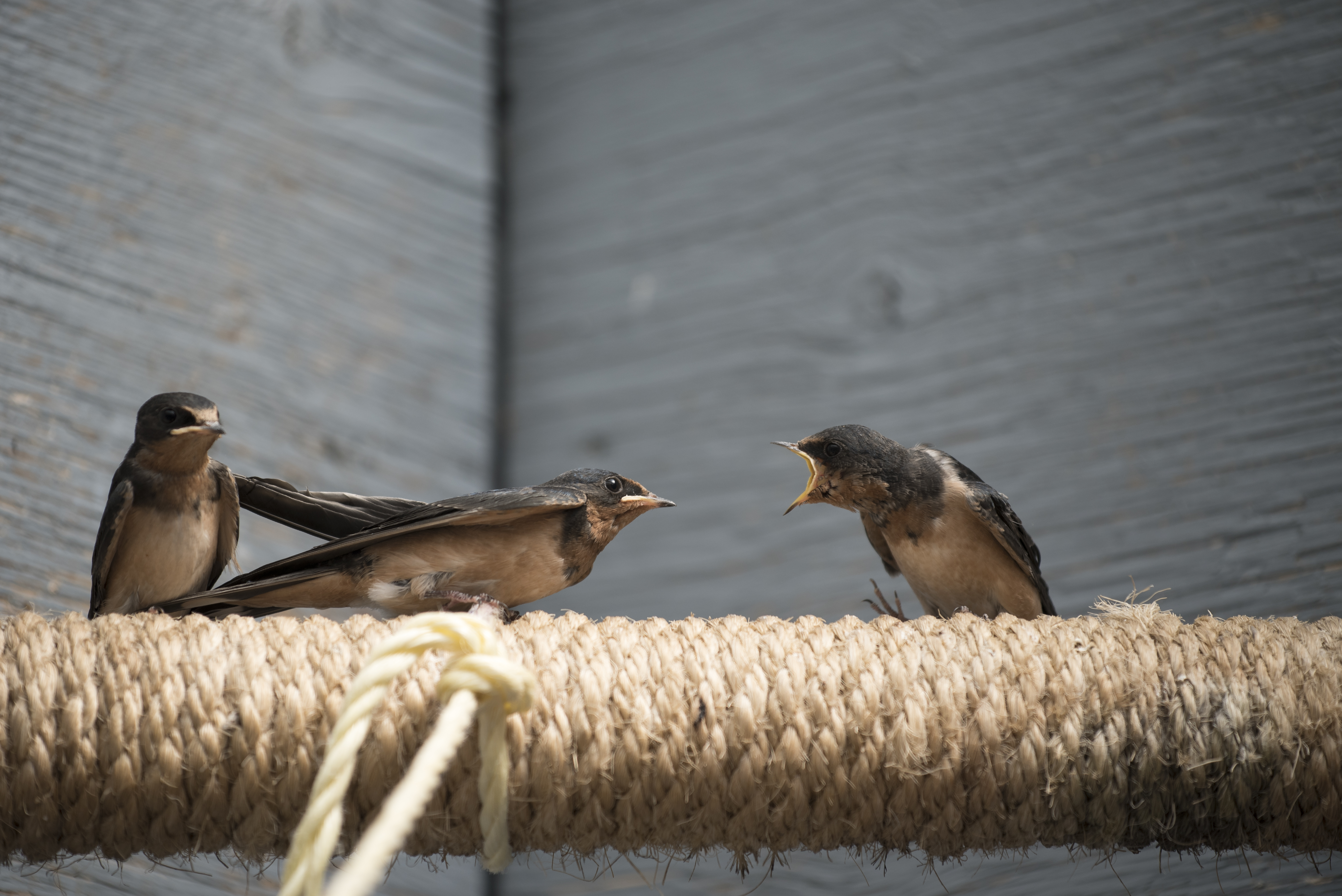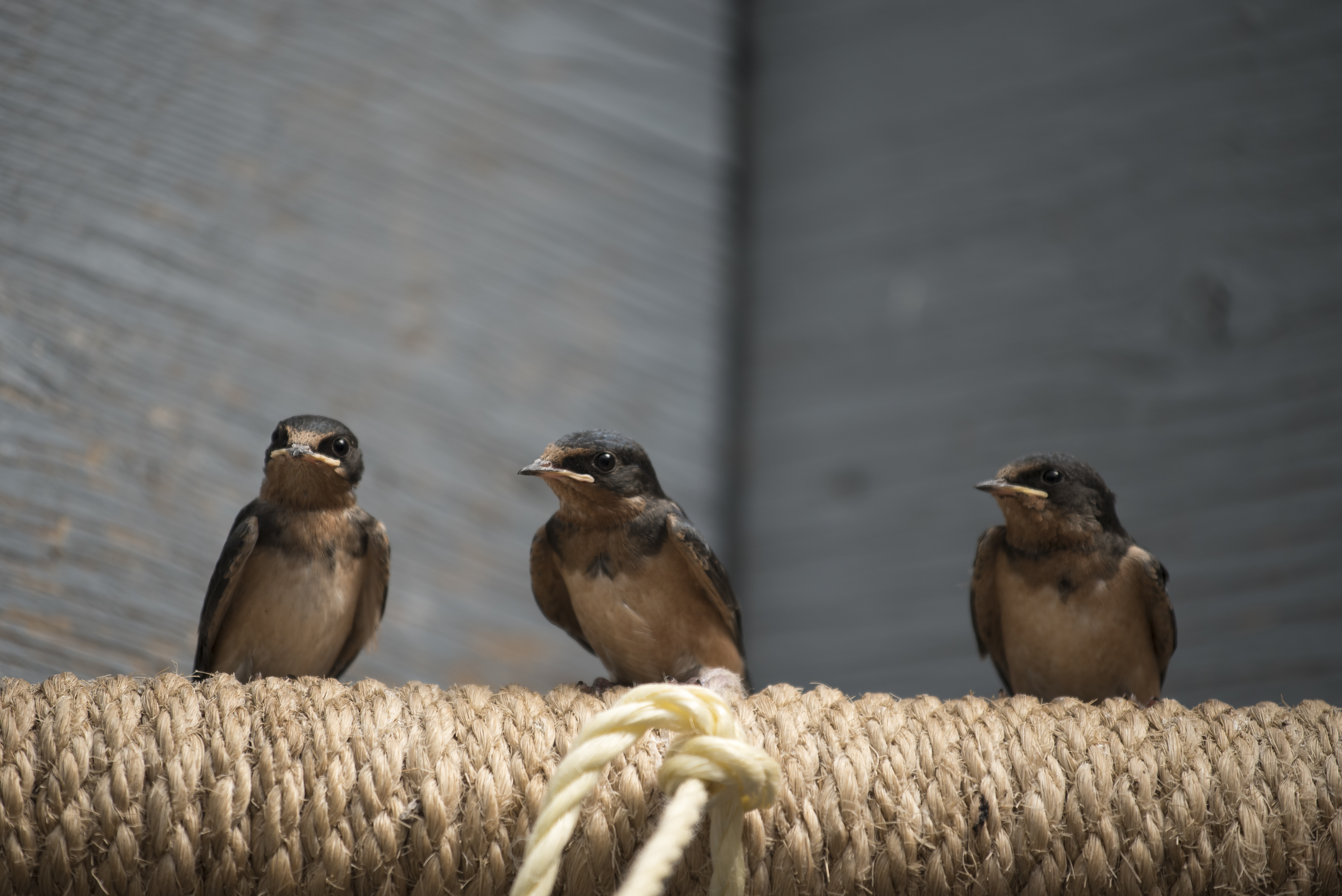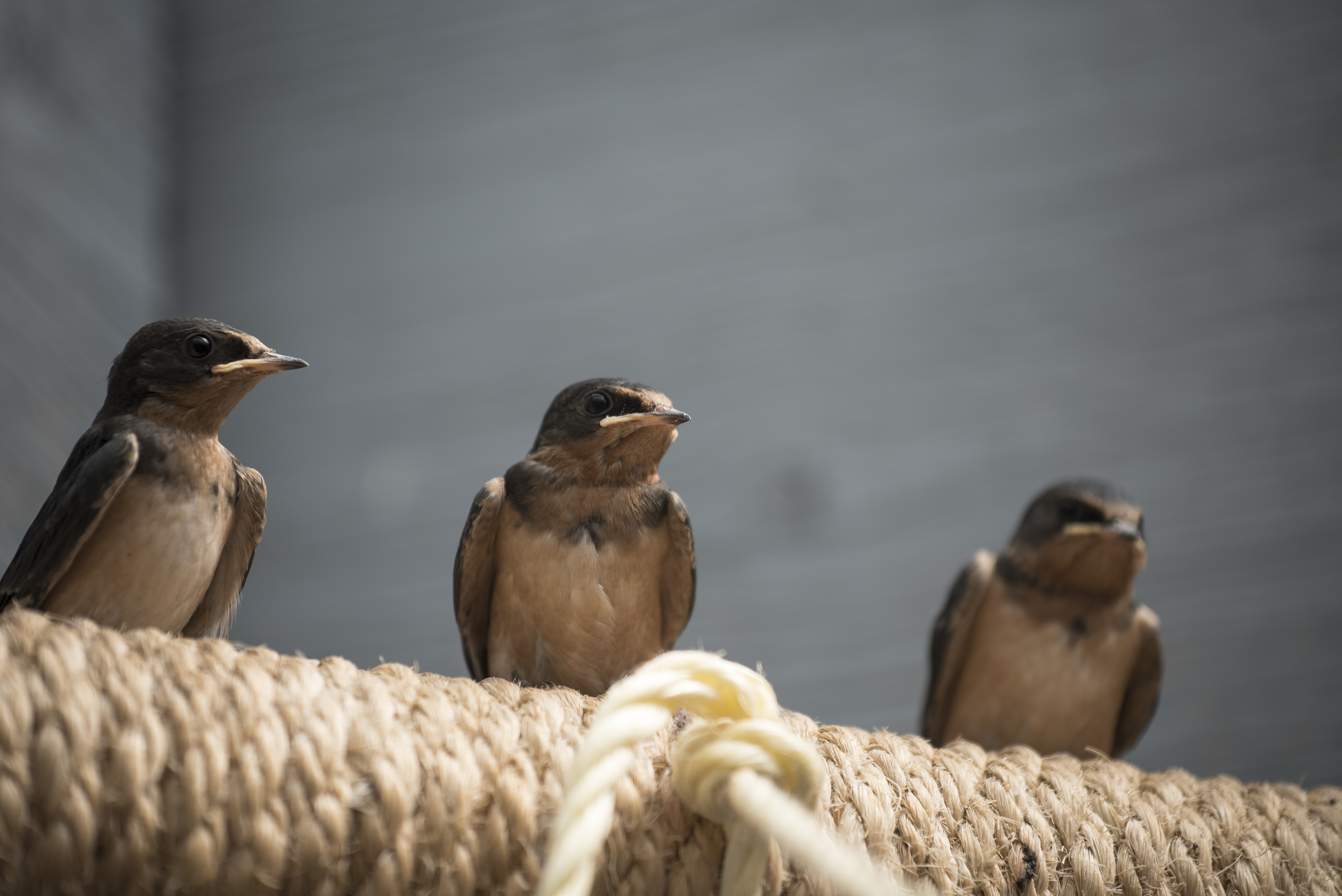You may have noticed the swift flight of little birds as you drive over a bridge, walk along a creek or float down the river. These birds are swallows, the topic of this blog!
Swallows are members of the Passeriformes order, colloquially referred to as passerines. Passerines are the most common order of birds, and include more than half of all the bird species. Swallows can easily be identified by their small size and deep fork in their tails. Ancient mythology alludes that the swallow has a forked tail because it stole fire from the gods to bring to people. One of the gods was not happy about it and retaliated by throwing a fireball at the swallow, singeing away the swallow’s middle tail feathers (Cornell University 2015a).
Several swallow patients are admitted to AIWC every year, and often these patients are young nestlings which require feedings every 30 minutes (this is very time intensive!). Lovely donations of knitted bird nests (imagine tiny touques) that we have received in the past mimic natural nests and help swallow nestlings stay close to their siblings. The swallows pictured in this blog were intakes as nestlings because their nest had been attacked by a cat. Through help from our dedicated staff, volunteers, and donations from you, they will soon be ready to be released back into the wild, their natural habitat!
One of the most fascinating things about swallows is how these birds demonstrate smooth aerial acrobatics. They can be seen diving and darting in all directions and are very much in control of their flight paths. Swallows are aerial insectivores, meaning they catch insects in flight as their main source of food (it can be quite captivating to see first-hand!).
Swallow nestling patients that we receive at AIWC are formula-fed from before they even open their eyes, and are fed mealworms by tweezers as they get bigger. Once they graduate into an outdoor enclosure, they are encouraged to fly around and have been known to steal mealworms from a pair of tweezers that were meant to be fed to another swallow waiting nearby for their meal. Patients who demonstrate this behaviour have a high chance of success in the wild!
Swallows can have bright or dark but iridescent or metallic feathers. The barn swallows in these photos have iridescent blue feathers on their heads, and tawny brown/rust-coloured feathers on their necks, and a fawn colour on their chests.
Cliff swallows are the most similar in colour to barns swallows but are mostly grey with a tawny brown/rust-coloured neck, blue head, and white spot on their foreheads. While tree swallows are white blue, violet-green swallows are emerald green and white, and northern rough-winged swallows and bank swallows are mostly brown.
Although there are several different species of swallows that may appear similar in size, behavior and sometimes colour, they have each adapted to their own unique habitat.
Table 1 – Habitat comparison of different species of swallows
| Species | Habitat |
| Barn Swallow | Feeds in open habitats from fields, parks, and roadway edges to marshes, meadows, ponds, and coastal waters. Nests are often under the eaves of buildings, inside sheds or barns, sides of bridges, and other structures (Cornell University 2015a). |
| Tree Swallow |
Breed in open habitats such as fields and wetlands, usually near water. Nest in artificial nest boxes and tree cavities. Feeds in flocks over wetlands, water, and agricultural fields (Cornell University 2015b). |
| Cliff Swallow |
Feed in areas near and over water, frequently mixing with other species of swallows. They have adapted to bridges, overpasses, and culverts as their colonial nesting sites (Cornell University 2015c). |
| Violet-Green Swallow |
Breed in open woodlands including deciduous, evergreen, and mixed species woodlands, especially where old cavity-filled trees occur. They feed near lakes and streams where they forage for flying insects (Cornell University 2015d). |
| Northern-rough Winged Swallow |
Breed in a wide range of open habitats, with openings in various vertical surfaces, including banks, gorges, and human structures (Cornell University 2015e). |
| Bank Swallow |
Live in low areas along waterbodies such as rivers, streams, ocean coasts, or reservoirs. Usually live near vertical cliffs or banks where they nest in colonies of 10 to 2,000 nests. Man-made sites, such as sand and gravel quarries or road cuts, are also suitable habitat (Cornell University 2015f). |
Time for some interesting facts about swallows that you might not have already known!
- The barn swallow is the most abundant and widely distributed swallow species in the world (Cornell University 2015a).
- Barn swallow parents may receive help from other birds to feed their young and these helpers are most likely older siblings from previous clutches, but could also be unrelated juveniles (Cornell University 2015a). This behaviour is also seen in crows and other corvids.
- Tree swallows can form large flocks (reaching hundreds of thousands) during migration and throughout winter. They gather as dense cloud above their roost site in the evening, and can resemble a tornado as they fly in unison (Cornell University 2015b).
- Cliff and bank swallows usually nest in colonies and colonies can reach up to several thousand (2,000 to 3,700) nests in one spot (Cornell University 2015c,f).
- Some cliff swallows may lay eggs in their own nest, or other nests in their colony. They have been seen transplanting one of their eggs to another nest by carrying it in their beak (Cornell University 2015c).
- Cliff swallows will call out to other cliff swallows to alert them when a large swarm of insects is nearby (Cornell University 2015c).
- Violet-green swallows have been recorded flying at 45 km/h (the Peregrine Falcon is the fastest bird of prey and averages about 40 to 56 km/h (Cornell University 2015d).
- The northern rough-winged swallow is named due to the outer wing feathers, which have small hooks or points on their leading edges (Cornell University 2015e).
- The male bank swallow has been known to pursue females other than his mate at the colony in an attempt to mate with them (Cornell University 2015f).
Remember, if you see injured or orphaned wildlife, you can contact AIWC (403-946-2361) for help and assistance if you think the animal is in distress.
By Tayler Hamilton, AIWC Volunteer
References:
Cornell University. 2015a. Barn Swallow. https://www.allaboutbirds.org/guide/Barn_Swallow/id. Accessed August 14, 2017.
Cornell University. 2015b. Tree Swallow. https://www.allaboutbirds.org/guide/Tree_Swallow/id. Accessed August 14, 2017.
Cornell University. 2015c. Cliff Swallow. https://www.allaboutbirds.org/guide/Cliff_Swallow/id. Accessed August 14, 2017.
Cornell University. 2015d. Violet-Green Swallow. https://www.allaboutbirds.org/guide/Violet-green_Swallow/id. Accessed August 14, 2017.
Cornell University. 2015e. Northern Rough-Winged Swallow. https://www.allaboutbirds.org/guide/Northern_Rough-winged_Swallow/id. Accessed August 14, 2017.
Cornell University. 2015f. Bank Swallow. https://www.allaboutbirds.org/guide/Bank_Swallow/id. Accessed August 16, 2017.









